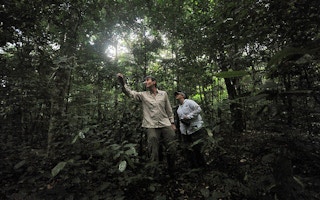Actively involving indigenous peoples and local communities in wildlife conservation is key to maintaining biodiversity and ensuring sustainable rural livelihoods, FAO said 3 March on the occasion of World Wildlife Day.
The urgent challenges that the world faces in maintaining biodiversity worldwide requires that indigenous peoples are empowered to act at the national level with assistance from the international community, FAO said.
“The cultures of indigenous peoples and local communities involve the stewardship of wildlife. They simply cannot imagine their life divorced from nature and their interest in the sustainable use of resources is strong,” said Eva Müller, Director of FAO’s Forestry Policy and Resources Division.
“Empowerment of these groups combined with their knowledge and long-term planning skills is essential to ensure the survival of future generations - of both humans and wildlife”.
The relationship between humans and wildlife is highlighted in a new edition of FAO’s quarterly forestry publication Unasylva, also released 3 March.
The publication is jointly produced by the Collaborative Partnership on Sustainable Wildlife Management (CPW), comprising 14 international organizations and secretariats, including FAO.
The publication cites several case studies from various countries to illustrate how indigenous peoples can optimise the benefits for their livelihoods while also safeguarding wildlife, provided they are given the rights to make their own decisions in the territories they inhabit.
“
The cultures of indigenous peoples and local communities involve the stewardship of wildlife. They simply cannot imagine their life divorced from nature and their interest in the sustainable use of resources is strong.
Eva Müller, director, Forestry Policy and Resources Division, UN FAO
In the northern part of Mount Kenya, for instance, the Il Lakipiak Maasai (“People of Wildlife”) own and operate the only community-owned rhino sanctuary in the country. These indigenous peoples have managed to alleviate the human - wildlife conflicts that arise in the area due to the intrusion of wild animals searching for water, prey and pasture during drought.
They achieved this by reducing bush-cutting to ensure more fodder for wildlife on their lands. Through this conservation strategy, indigenous peoples have demonstrated that they can coexist harmoniously with wildlife while supporting their own pastoral lives and cultures.
Finding ways leading humans and wildlife to a mutually beneficial co-existence
Several wildlife species may cause significant damage to crops and livestock systems, threatening peoples’ food security, safety and well-being.
In extreme cases, attacks by wildlife species such as elephants and crocodiles can cause human injuries and death, the publication noted.
Human-wildlife conflicts have become more frequent and severe particularly in Africa, due to increasing competition for land in previously wild and uninhabited areas.
This is often the result of human population growth, increasing demand for natural resources, and growing pressure for access to land, such as expansion of transport routes, agriculture and industries.
More specifically, the publication stresses that in central and southern Africa, wildlife and people will continue to share landscapes and resources with conflicts likely to worsen unless actions are taken.
In view of this, FAO, the French Agricultural Research Centre for International Development (CIRAD) and other partners have developed the first Human-Wildlife Conflict (HWC) toolbox, which has helped a local community in Gabon’s Cristal Mount National Park.
Local farmers in this area were particularly frustrated by the fact that animals such as cane rats, roan antelopes, bush pigs and elephants, were destroying their entire crops, and thus threatening their livelihoods.
At the same time, laws prohibited these farmers from taking action by hunting the protected animals either for meat or to protect their crops.
Solutions offered by the toolkit included fencing the plantations to block animals from reaching the crops, lighting fires or making noises to scare the animals away, and posting guards to keep watch on plantations at night - measures that were relatively easy and inexpensive to implement.
Trophy hunting could benefit rural poor and wildlife
The publication also touches upon the controversy over trophy hunting, arguing that, if well managed, it can play a positive role in supporting conservation as well as livelihoods of poor people in rural areas.
It says that the impact of blanket bans on trophy hunting can be detrimental for indigenous peoples and the environment, and that a more nuanced approach is needed.
In many contexts, trophy hunting overlaps with hunting for food. Many deer hunters, for example, may hunt animals with larger antlers as trophies, but if they cannot find these, they will hunt others for meat.
In addition, benefits to land owners from hunting can make wildlife an attractive land-use option, encouraging them to maintain and restore wildlife habitat and populations and carry out anti-poaching activities.
For example, in the Pamirs in Tajikistan, trophy-hunting concessions for wild sheep and goats are showing higher densities of the threatened snow leopard than in nearby areas without trophy hunting. This is likely due to higher prey densities and reduced poaching.
There are valid concerns about legality, sustainability and ethics of some hunting practices, and the contributions of trophy hunting to the livelihoods of local communities and wildlife vary enormously by context and region.
In some cases, there may be feasible alternatives to trophy hunting that can deliver the same benefits for wildlife and people, but identifying and implementing these requires engagement with national governments, the private sector and communities, the publication concludes.








